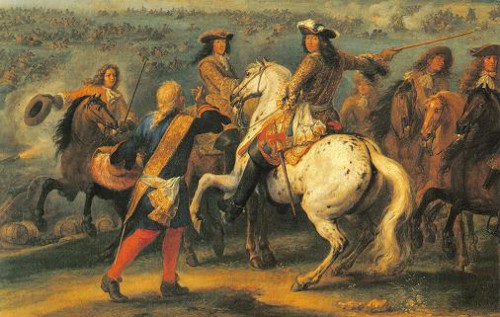An oxymoron? Bear with me….
 “Advance to Barbarism: The Development of Total Warfare from Sarajevo to Hiroshima,” by FJP Veale.
“Advance to Barbarism: The Development of Total Warfare from Sarajevo to Hiroshima,” by FJP Veale.
Veale describes the eighteenth and nineteenth centuries as a period, mostly, of civilized warfare in Europe or regions influenced by European culture.
I will point out only once that the complete contrast to warfare as practiced today – and certainly since at least the Second World War – by the West when compared to this code; to make mention of this at each possible opportunity will only serve to double the length of this post. I hope even the most casual observer of today’s realities can see how far those in the several militaries of various western governments have fallen.
So, what is meant by “civilized warfare”?
…this code was based on one simple principle, namely that warfare should be the concern only of the armed combatants engaged. From this follows the corollary that non-combatants should be left entirely outside the scope of military operations.
…it necessarily followed that an enemy civilian did not forfeit his rights as a human being merely because the armed forces of his country were unable to defend him.
The sufferings of civilians must never be made a means by which the course of hostilities can be influenced – for example, when, in accordance with the common practice of barbarous warfare, a country is deliberately laid waste to induce its rulers to surrender.
…a combatant who surrenders ceases to be a combatant and reacquires the status of non-combatant….a combatant who has become incapacitated through wounds or disease ceases to be a combatant….
…a prisoner of war should be treated by his captors as a person under military discipline transferred by his capture from the command of his own countrymen to the command of his captors.
…the code was safeguarded by the knowledge that violation, even if profitable at the moment, would bring ultimate retribution and the weakening of the general security enjoyed by all.
Veale does not ignore the exceptions to this type of civilized warfare during this period; many of the violations were committed by the British – safe in the security that, due to their superiority at sea, repercussions on the homeland were unlikely. Veale also notes that this code did not mean that towns were off-limits, only that a direct military objective was necessary for the action to be justified.
As a counter-example, Veale offers France, Austria and Russia against Prussia during the Seven Years War; they could easily have overrun Prussia if barbarous methods were employed:
All that was necessary to bring about Frederick’s speedy downfall was to pour across the open and exposed frontiers of Prussia small units of Hungarian hussars and Russian Cossacks with instructions to destroy everything which could be destroyed by means of a torch or a charge of gunpowder. The Prussian army would have been helpless in the face of such tactics, designed to turn Prussia into a desert.
The term Veale uses to describe this aspect of the culture is chivalry:
“Chivalry had two outstanding marks,” says Professor R.B. Mowat, “two that were as its essence: it was Christian and it was military.”
I can see the steam coming out of Laurence Vance’s ears even now. But trust me, it will all come together into something meaningful.
Chivalry, as it ultimately developed, became a collective term embracing a code of conduct, manners, and etiquette, a system of ethics and a distinctive “Weltanschauung” (philosophy of life) as the Germans call it. For our purpose, its principal importance is that, when the code of chivalry was adopted as the code of the military caste in all the European states, it provided a common bond between them.
The soldiers fought as (relatively speaking) gentlemen, as opposed to the experience in war proceeding this chivalrous age:
Sadism could no longer masquerade as moral indignation….
I like that line….
As the subtitle of this book suggests, this was all to change in the first half of the twentieth century. Sadism put on its mask once again.
There were many aspects of this chivalrous nature evident during the Middle Ages:
…it can be said that the general acceptance of the ideals of chivalry had considerable influence on the conduct of warfare in the Middle Ages, although this influence was generally restricted in practice to dealings of the ruling classes with each other.
…the code of chivalry had been readily accepted throughout Europe because the ruling classes in all countries accepted the teaching of the Catholic Church and acknowledged the spiritual supremacy of the Pope.
As the wars in the Middle Ages were often conducted by and between the ruling classes, this distinction is of little consequence.
Civilians had little to fear from the dangers of war which were the concern only of professional soldiers.
This period of relative chivalry came to an end during the sixteenth and seventeenth centuries; Veale points to the invasion of Italy by Charles VIII of France in 1494 as marking the beginning of the end of this relatively “civilized” period. Italy was subject to foreign invaders – French, German, Swiss and Spanish, “who recognized no rules of warfare of any kind,” waging war “with the most primitive ferocity and resulting in enormous loss of life and causing irreparable damage.”

The development (or re-discovery) of chivalrous behavior and civilized warfare can be traced to another French king, Louis XIV – or, more precisely, coincident to his reign: “no traces of it can be detected at the beginning of his reign in 1643, and it appears fully established at his death in 1715. No credit for this development, however, can be attributed to Louis personally.”
On the contrary, one of the most deliberate and least excusable barbarities in European history was perpetrated by his armies as late as 1689 when the Palatinate was systematically devastated in order to create an Odlandsgürtel(waste-land-zone) along the French frontier.
In response to the capture by French forces of several German towns in the south and west, German princes mobilized the forces of northern Germany – in an attempt to recover what had been lost. Louis responded with his scorched-earth policy:
Realising that the war in Germany was not going to end quickly and that the Rhineland blitz would not be a brief and decisive parade of French glory, Louis XIV and Louvois resolved upon a scorched-earth policy in the Palatinate, Baden and Württemberg, intent on denying enemy troops local resources and prevent them invading French territory. By 20 December 1688 Louvois had selected all the cities, towns, villages and châteaux intended for destruction. On 2 March 1689 Count of Tessé torched Heidelberg; on 8 March Montclar levelled Mannheim. Oppenheim and Worms were finally destroyed on 31 May, followed by Speyer on 1 June, and Bingen on 4 June. In all, French troops burnt over 20 substantial towns as well as numerous villages.
Not very civilized.
The French general ordered to destroy Heidelburg reported to Louivois, the secretary of war, “I must represent to His Majesty the bad effect which such a desolation may make upon the world in respect to his glory and reputation.” Such a thought would not have occurred to a general during the Thirty Years War, when such devastation was considered normal.
Condemnation of the devastation of the Palatinate was, indeed, general…
So why does Veale point to Louis XIV? During this period, the ruling classes throughout Europe all became…French! They had “become linked by a similar outlook – by similar tastes, manners and standards – originating at the Court of Louis XIV.”
To be a European gentleman meant to be a French gentleman. The ruling classes of France, Germany, and Russia had more in common with each other than they did with their own countrymen.
From this it naturally followed that the officers of the various European armies, when they came in contact, should treat each other with elaborate courtesies in accordance with the manners of the time.
Veale offers several examples of such courtesies being extended: after the surrender of Lille by Marshal Bouffiers, by Frederick the Great toward the French engineer Gribeauval, by Admiral Keith toward Marshal Massena after the latter’s surrender at Genoa.
Veale contrasts these with the attitudes today:
Even if acts of courtesy took place in war to-day, the report of them would be suppressed for fear of outraging public opinion.
And public opinion means much in wars conducted by democracies; the other side must remain evil, such that the masses continue to support the fight. Who would extend courtesy to evil?
While such gentlemen-officers were duty bound to support any war policy initiated by the politicians, the manner in which the war was conducted rested solely on the shoulders of those same officers:
…the manner of conducting a war, whether just or unjust, was recognized to be the sole concern of the professional soldiers conducting it.
This code was respected in wars between European powers; it did not apply always and everywhere. For example, a British general, lent to the Chinese government in 1863, “[t]o his horror” witnessed the beheadings of a number of rebel leaders who had surrendered.
Then there was the matter of treatment of civilians and non-combatants:
Of more practical importance than the code of good manners which it imposed on the combatants was the security given to civilian life and property by the introduction of civilized methods of warfare.
No massacre of civilians; pillage replaced by requisition with payment. The Austrians and Germans were quite strict about ensuring this discipline, for example:
In the Prussian Army, the regulations against looting were so strict that, after the disaster at Jena in 1806, it is recorded that the retreating Prussians endured without fires the bitter cold of an October night in central Europe rather than seize civilian stores of wood which lay to hand but for which they were unable to pay.
Civilized warfare reached its peak in the last half of the eighteenth century. Veale notes a book by Emeric de Vattel of Switzerland, The Law of Nations, or the Principals of Natural Law as Applied to the Administration of National Affairs and of Sovereigns:
Not only does Vattel point out that, if barbarous methods of warfare are adopted, the enemy will do likewise, so that the only ultimate result will be to add to the horrors of war; not only does he argue that “harsh, disgraceful and unendurable peace terms” will only be fulfilled as long as the defeated enemy lacks the means to repudiate them; Vattel actually condemns the use by rulers at war of “offensive expressions indicating sentiments of hatred, animosity, and bitterness” since such expressions must ultimately stand in the way of a settlement on reasonable terms.
 Vattel points out that war as a means to settle disputes “can only serve this purpose if, in the first place, it be conducted by methods which do not leave behind a legacy of hatred and bitterness…”
Vattel points out that war as a means to settle disputes “can only serve this purpose if, in the first place, it be conducted by methods which do not leave behind a legacy of hatred and bitterness…”
Vattel did not write something unknown to the military leaders and politicians of the time and place; this was their practice. Instead, he merely tried to boil these behaviors down to a concise code. He could not conceive of the possibility that Europe might once again turn to the code of slaughter that was evident during the Thirty Years War – Magdeburg of 1631 returning in the form of Dresden in 1945.
Yet, we know it did. In the next chapter, Veale begins to trace the history of this reversion, or – as he describes it – this “Advance to Barbarism.”
Reprinted with permission from Bionic Mosquito.




 del.icio.us
del.icio.us
 Digg
Digg